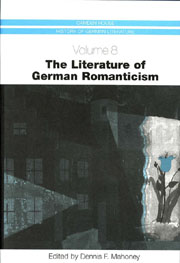Book contents
- Frontmatter
- Contents
- Illustrations
- Acknowledgments
- Abbreviations
- Introduction
- From “Romantick” To “Romantic”: The Genesis of German Romanticism in Late Eighteenth-Century Europe
- Goethe and the Romantic
- Early Romanticism
- From Goethe's Wilhelm Meister to anti-Meister Novels: The Romantic Novel between Tieck's William Lovell and Hoffmann's Kater Murr
- Tales of Wonder and Terror: Short Prose of the German Romantics
- The Romantic Drama: Tieck, Brentano, Arnim, Fouqué, and Eichendorff
- German Romantic Poetry in Theory and Practice: The Schlegel Brothers, Schelling, Tieck, Novalis, Eichendorff, Brentano, and Heine
- The Turn to History and the Volk: Brentano, Arnim, and the Grimm Brothers
- History and Moral Imperatives: The Contradictions of Political Romanticism
- Romanticism and Natural Science
- Gender Studies and Romanticism
- The Romantic Preoccupation with Musical Meaning
- Romanticism and the Visual Arts
- Goethe's Late Verse
- The Reception of German Romanticism in the Twentieth Century
- Works Cited
- Notes on the Contributors
- Index
Introduction
Published online by Cambridge University Press: 05 February 2013
- Frontmatter
- Contents
- Illustrations
- Acknowledgments
- Abbreviations
- Introduction
- From “Romantick” To “Romantic”: The Genesis of German Romanticism in Late Eighteenth-Century Europe
- Goethe and the Romantic
- Early Romanticism
- From Goethe's Wilhelm Meister to anti-Meister Novels: The Romantic Novel between Tieck's William Lovell and Hoffmann's Kater Murr
- Tales of Wonder and Terror: Short Prose of the German Romantics
- The Romantic Drama: Tieck, Brentano, Arnim, Fouqué, and Eichendorff
- German Romantic Poetry in Theory and Practice: The Schlegel Brothers, Schelling, Tieck, Novalis, Eichendorff, Brentano, and Heine
- The Turn to History and the Volk: Brentano, Arnim, and the Grimm Brothers
- History and Moral Imperatives: The Contradictions of Political Romanticism
- Romanticism and Natural Science
- Gender Studies and Romanticism
- The Romantic Preoccupation with Musical Meaning
- Romanticism and the Visual Arts
- Goethe's Late Verse
- The Reception of German Romanticism in the Twentieth Century
- Works Cited
- Notes on the Contributors
- Index
Summary
At the end of the eighteenth century, there occurred an outburst of intellectual, literary, and artistic creativity within German-speaking lands that signaled the start of the Age of Romanticism throughout Europe and even the Americas. While many literary historians of the nineteenth and early twentieth centuries regarded German Romanticism as the polar opposite to Enlightenment rationalism — with the evaluation of such a purported opposition depending on the ideological orientation of the critic — it might be more productive to view the Romantic era in Germany as a time when discordances latent in eighteenth-century society and thought became manifest. In this way, Enlightenment and Romanticism become part of a continuum of development in European intellectual history that also includes more narrowly confined literary movements in Germany such as the Sturm und Drang and Weimar Classicism.
Within German Romanticism itself it is customary to distinguish at least two and perhaps even three phases in the years between 1795 and 1830 — Früh-, Hoch-, and Spätromantik (Early, High, Late Romanticism) — whereby the middle attribute then suggests a high point to the movement in the years between 1805 and 1815 before it either lapsed into repetitive self-parody or was superseded by other groups and directions in nineteenth-century literature. Regardless of whether one chooses to accept this tripartite division or else simply speaks of Early and Late Romanticism, there is no doubt that the first phase of this movement overlaps with the literary partnership of Goethe and Schiller between 1794 and 1805 known as Weimar Classicism.
- Type
- Chapter
- Information
- The Literature of German Romanticism , pp. 1 - 24Publisher: Boydell & BrewerPrint publication year: 2003



